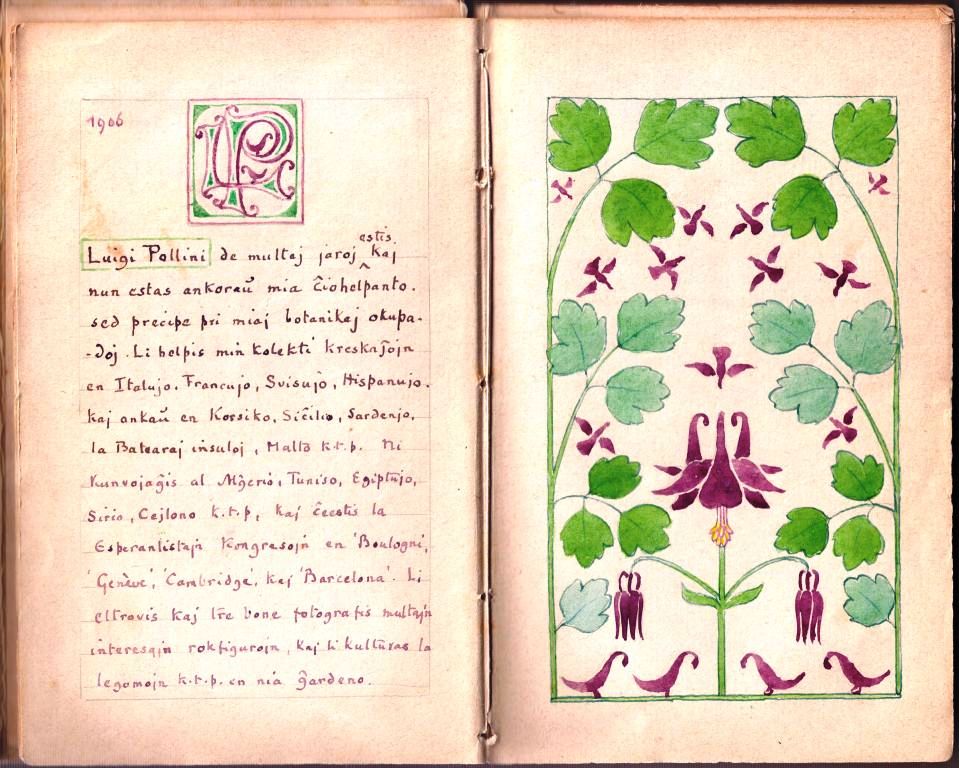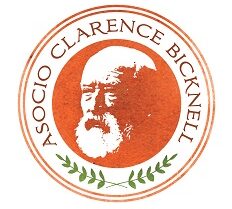
A decorative floral design by Clarence Bicknell from his Book of Guests in Esperanto. Here he plays tribute to one of his best friends and helpers; “Luigi Pollini was for many years and still is my factotum, but particularly for my botanical interests. He helped me collect plants in Italy, France, Switzerland, Spain, and also in Corsica, Sicily, Sardinia, the Balearic Islands, Malta, etc. We travelled together to Algeria, Tunis, Egypt, Syria, Ceylon, etc. and attended the Esperantist Congresses in ‘Boulogne’, ‘Genève’, ‘Cambridge’ and ‘Barcelona’. He discovered and expertly photographed many interesting rock figures, and he cultivates the vegetables etc. in our garden.”
Aquilegia atrata L. – Dark columbine in English – Ancolie (Colombine cornette) in French – Auilegia scura or atrata or volgare ( also ‘amor nascosto’ ) in Italian. Family: Ranunculaceae
Area of distribution: West south Europe Alps and Italian Apennines. Description: Perennial herb, up to 50 cm high. Leaves composed of 3-9 leaflets. Upper stem leaves are smaller. Flowers in clusters on long stalks, pendent, blue-violet or blackish, from petals start curved spurs. Stamens are long and come out from corolla. Growing in deciduous woods often of red firs (Picea abies L.) and rocky cliffs from 500 to 2000 m. Much and long cultivated in flower gardens with similar species of different colours coming from other continents. Flowering time: from May to July. Etymology: Aquilegia could derive from latin ‘aqua legere’ as for its shape the flower look as a bowl for water. Aquilegia could more simpler come from ‘eagle’ (aquila).

Clarence wrote in this small vellum-bound album his notes in Esperanto on guests who had spent the night in the Casa Fontanalba, including four dogs, between 1910 and 1915. Each left-hand page shows notes on a guest in coloured ink with their initials illuminated; the right-hand page shows a watercolour of a flower found nearby, sometimes relevant to the person. The vellum-bound books, (about a dozen of them, of which seven are in the Fitzwilliam Museum in Cambridge), when new, are said to have been gifts to Clarence from Margaret Berry to whom he returned them when they were full. This Book of Guests in Esperanto is the only small format one recorded by the Clarence Bicknell Association. The album’s title differentiates this book from the Casa Fontanalba Visitors’ Book which contains only the signature of visitors. The complete list is available online www.clarencebicknell.com/documents
Text and photo, left, by Elisabetta Massardo in Nov. 2021 – No.52 in our series on works by Clarence Bicknell
